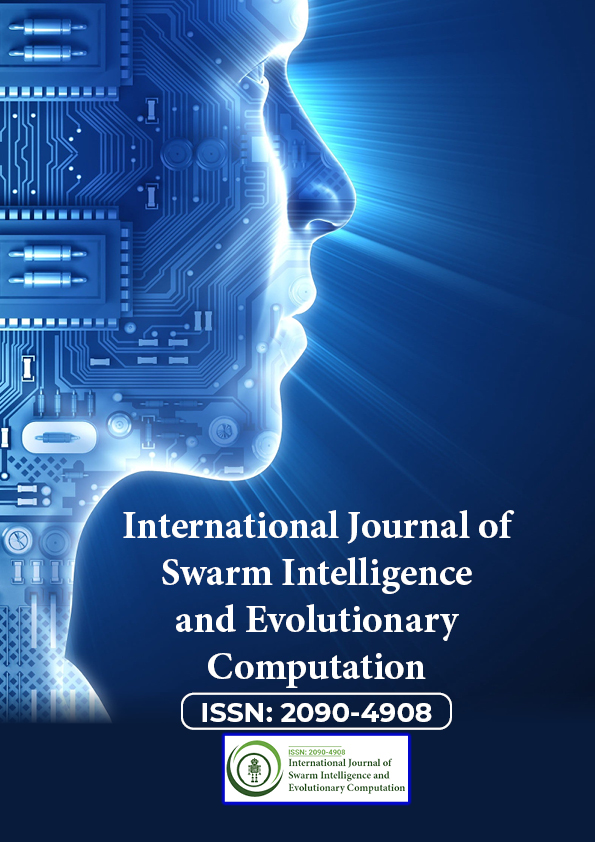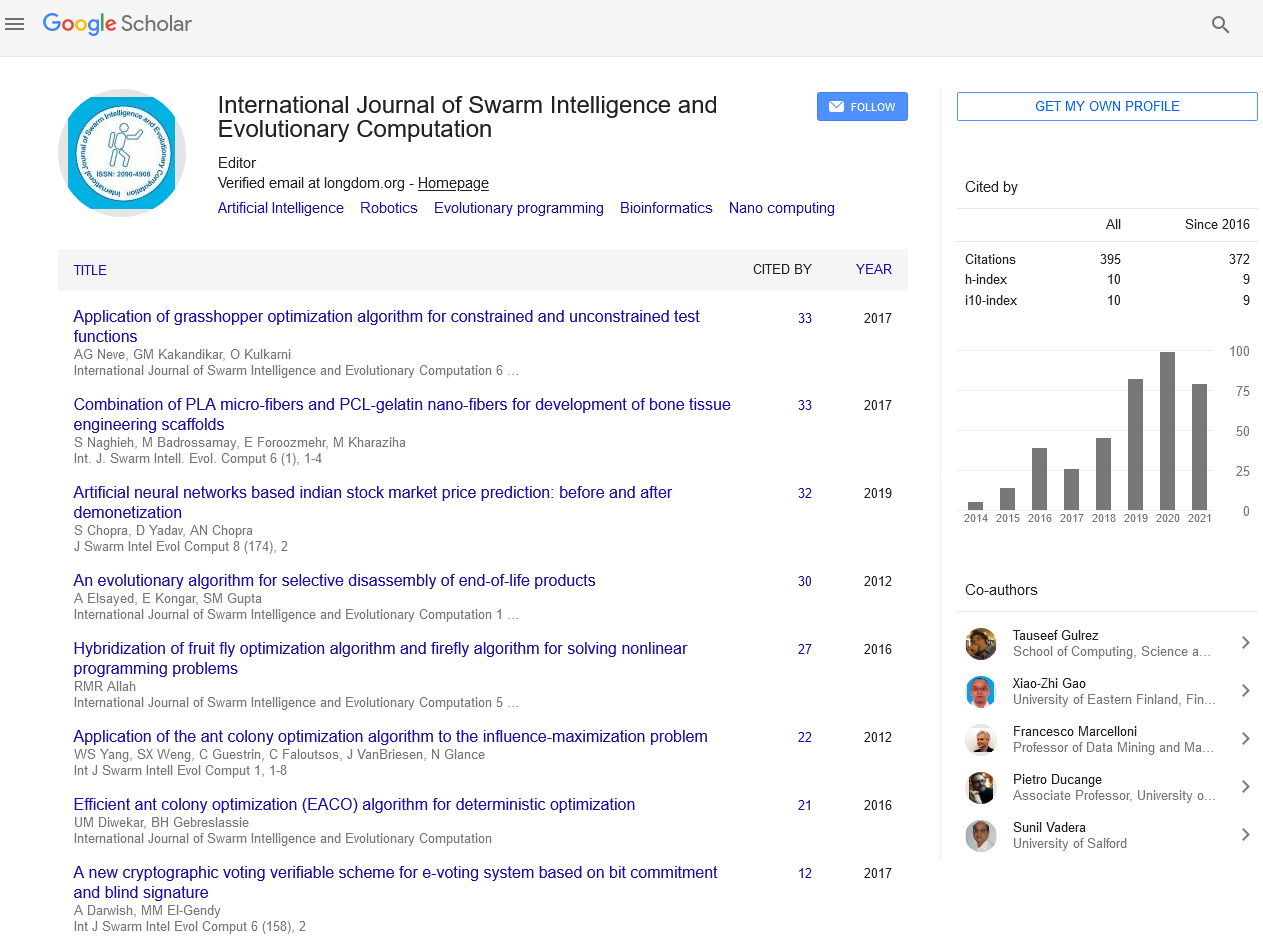Indexed In
- Genamics JournalSeek
- RefSeek
- Hamdard University
- EBSCO A-Z
- OCLC- WorldCat
- Publons
- Euro Pub
- Google Scholar
Useful Links
Share This Page
Journal Flyer

Open Access Journals
- Agri and Aquaculture
- Biochemistry
- Bioinformatics & Systems Biology
- Business & Management
- Chemistry
- Clinical Sciences
- Engineering
- Food & Nutrition
- General Science
- Genetics & Molecular Biology
- Immunology & Microbiology
- Medical Sciences
- Neuroscience & Psychology
- Nursing & Health Care
- Pharmaceutical Sciences
Commentary - (2024) Volume 13, Issue 5
Evolutionary Models of Collective Behavior in Swarm Intelligence
Zhengping Yan*Received: 26-Aug-2024, Manuscript No. SIEC-24-27463; Editor assigned: 28-Aug-2024, Pre QC No. SIEC-24-27463 (PQ); Reviewed: 11-Sep-2024, QC No. SIEC-24-27463; Revised: 18-Sep-2024, Manuscript No. SIEC-24-27463 (R); Published: 25-Sep-2024, DOI: 10.35248/2090-4908.24.13.396
Description
Swarm Intelligence (SI) is a intriguing field that studies the collective behavior of decentralized, self-organizing systems. In nature, examples of swarm behavior can be found in various species, such as ants finding food, birds flocking, or bees building hives. These collective behaviors emerge from the simple local interactions of individuals without a central command, yet they result in coordinated global patterns that solve complex problems. Inspired by these natural systems, researchers have developed computational algorithms that mimic these behaviors to solve optimization problems in fields such as machine learning, robotics and logistics.
Evolutionary models of collective behavior in swarm intelligence integrate principles of evolution and natural selection to improve problem-solving capabilities. These models use the concept of evolving populations of agents or particles that interact with one another in an environment, adapting to challenges in real-time. This article examines how evolutionary models influence swarm intelligence and their applications in optimization problems.
Evolutionary principles in swarm intelligence
The core idea behind evolutionary models in swarm intelligence is to simulate the process of natural evolution, where agents (whether particles, ants, or robots) evolve over generations based on their ability to solve problems. Agents in the system are typically evaluated based on their fitness—how well they contribute to solving a problem. Agents that perform better are more likely to reproduce and spread their strategies, allowing successful traits to propagate throughout the population.
In swarm intelligence, collective behavior emerges from local interactions among agents. The agents in a swarm follow simple rules, but as they interact and share information, these local actions lead to complex global outcomes. This is akin to how individual ants may have a simple task, such as searching for food, but together they can find the most efficient route to the food source. In swarm intelligence algorithms, this type of behavior is harnessed to explore and exploit solution spaces.
One of the most notable swarm intelligence algorithms is Particle Swarm Optimization (PSO), inspired by the social behavior of bird flocks. In PSO, individual "particles" (candidate solutions) move through the solution space, adjusting their positions based on their personal experience and the experience of the swarm. The particles share information on their bestfound solutions, allowing the swarm to gradually converge on an optimal solution. By incorporating evolutionary principles such as selection and mutation, PSO can explore diverse solution spaces and adapt to changes in the problem environment.
Evolutionary models allow swarm intelligence algorithms to adapt to changing environments. As agents interact with one another and their environment, they adjust their behavior in response to new challenges. This adaptability is particularly beneficial in dynamic or real-time optimization problems, where the problem space may evolve over time.
Evolutionary swarm intelligence algorithms examine multiple parts of the solution space simultaneously, which improves the likelihood of finding a global optimum. This parallel search capability allows swarm-based algorithms to handle highdimensional or multi-modal optimization problems more effectively than traditional methods that focus on a single solution path.
Swarm intelligence systems are robust in the face of failure or disruption. In nature, individual agents in a swarm can fail without disrupting the overall performance of the group. Similarly, in computational swarm intelligence systems, the failure of a few agents does not significantly impact the search process, making these systems more persistent.
Applications of evolutionary models in swarm intelligence
Evolutionary models of collective behavior have been successfully applied to a variety of optimization problems. For instance, in robotic swarm systems, multiple robots equipped with simple sensors and actuators can perform complex tasks such as analysis, mapping, or environmental monitoring. These robots adapt to each other’s actions and evolve strategies that lead to efficient collaboration.
In machine learning, evolutionary models are used to optimize the hyperparameters of algorithms, ensuring the best performance across diverse datasets. Particle Swarm Optimization, for example, has been applied to train artificial neural networks, where particles adjust weights and biases to find the optimal configuration.
Evolutionary models of collective behavior in swarm intelligence provide a powerful framework for solving complex optimization problems. By simulating the natural principles of evolution and decentralized cooperation, these algorithms enable efficient exploration of solution spaces, adaptation to changing environments, and the emergence of high-quality solutions. From robotic swarm systems to machine learning and logistics, evolutionary swarm intelligence continues to show promise in tackling real-world challenges. As the field evolves, we can expect even more sophisticated and efficient algorithms to emerge, unlocking new opportunities for optimization in various domains.
Citation: Yan Z (2024). Evolutionary Models of Collective Behavior in Swarm Intelligence. Int J Swarm Evol Comput. 13:396.
Copyright: © 2024 Yan Z. This is an open-access article distributed under the terms of the Creative Commons Attribution License, which permits unrestricted use, distribution, and reproduction in any medium, provided the original author and source are credited.


